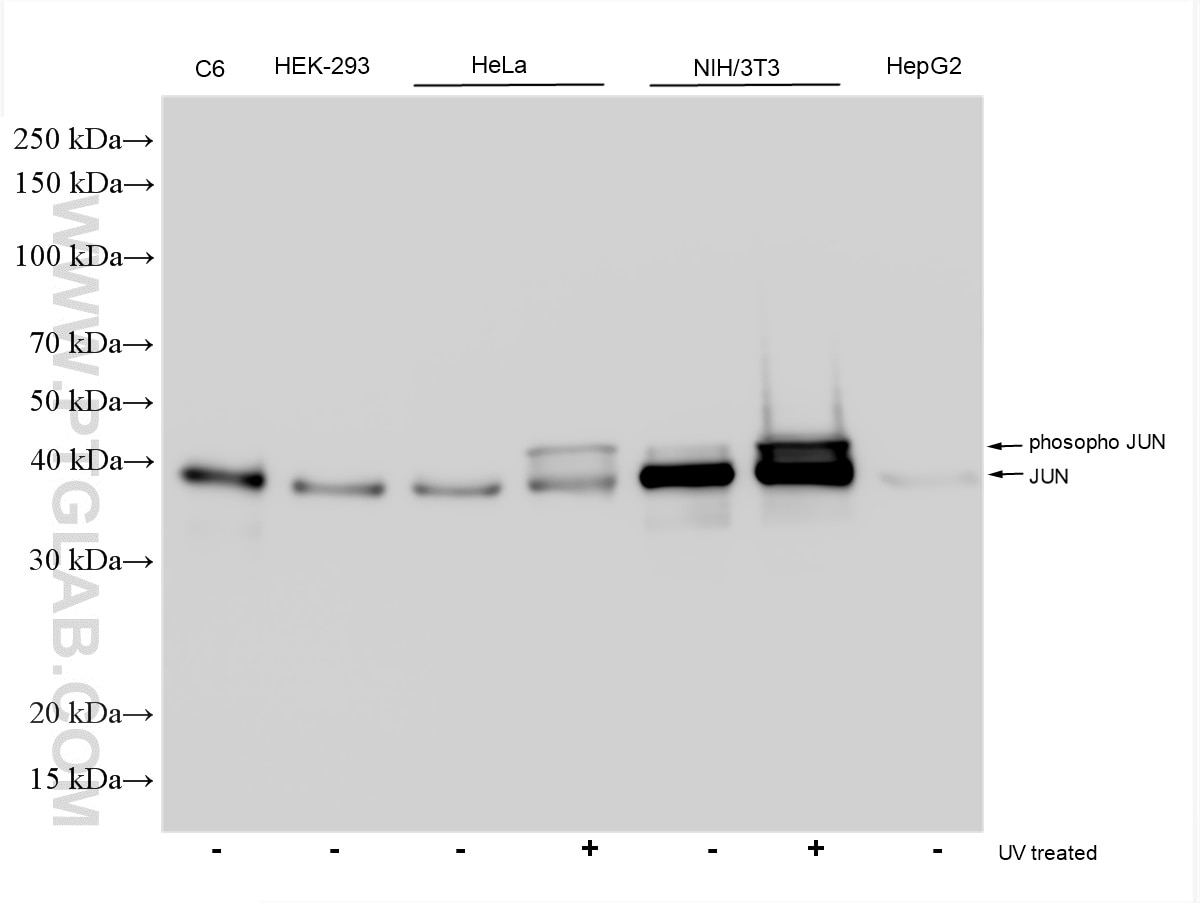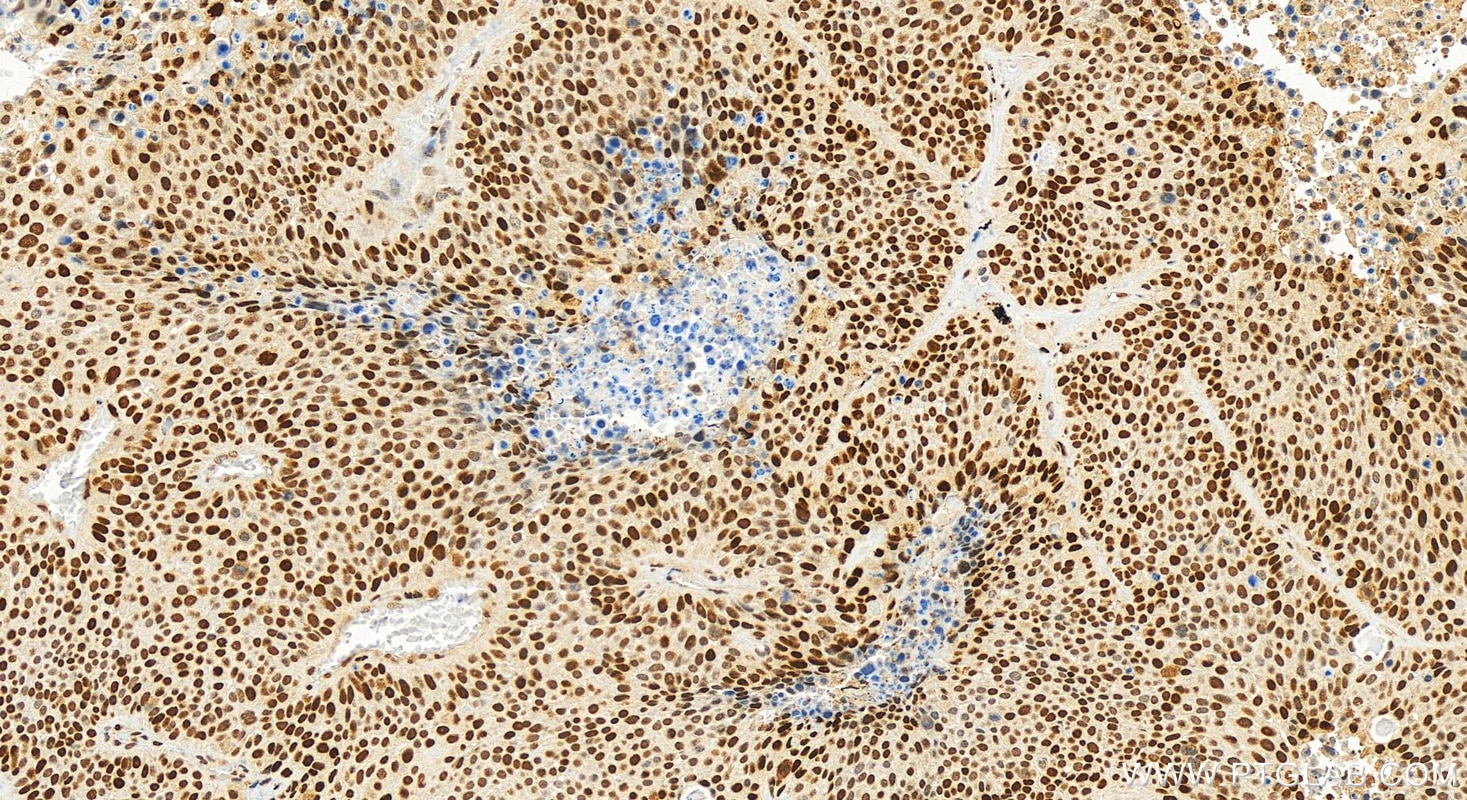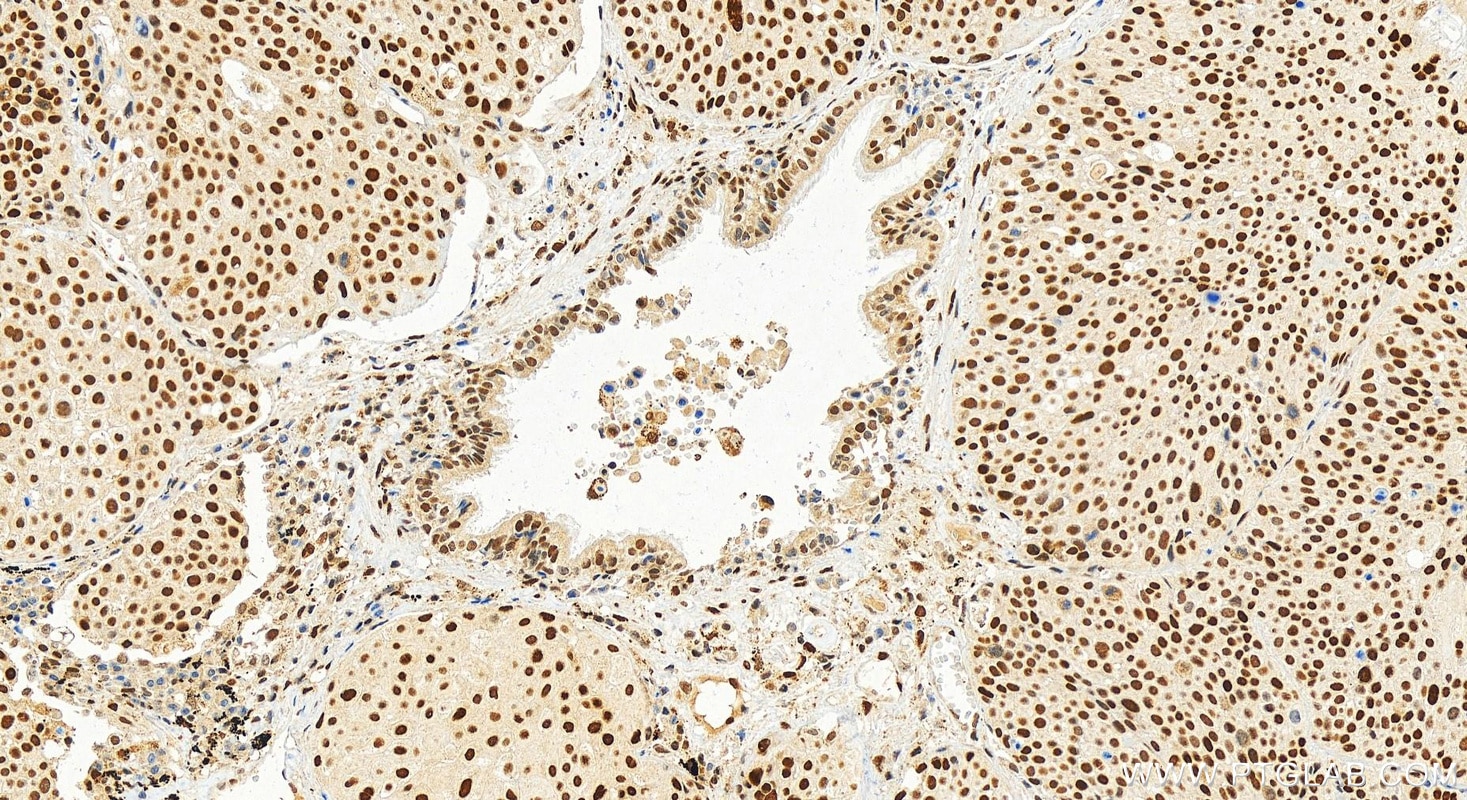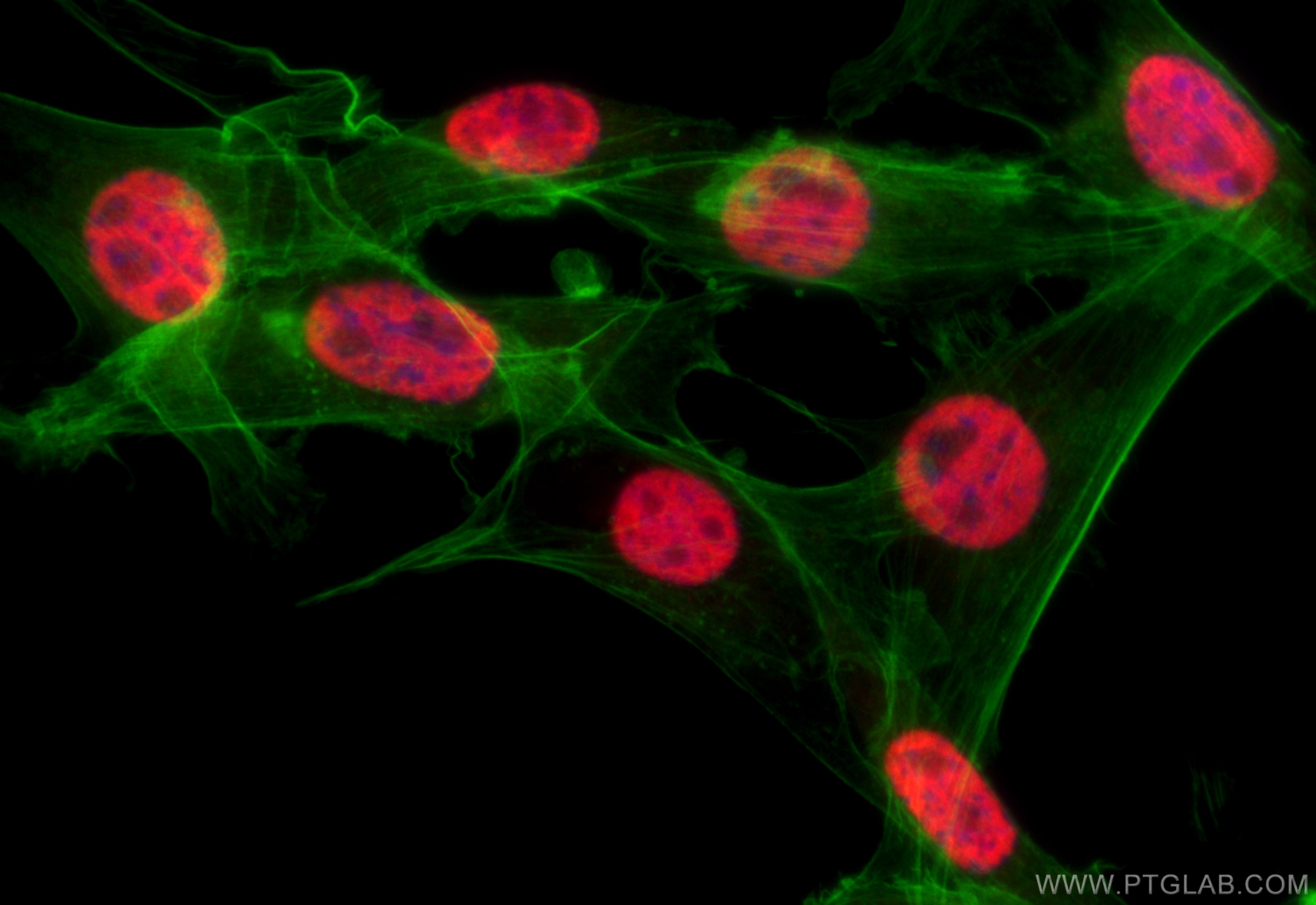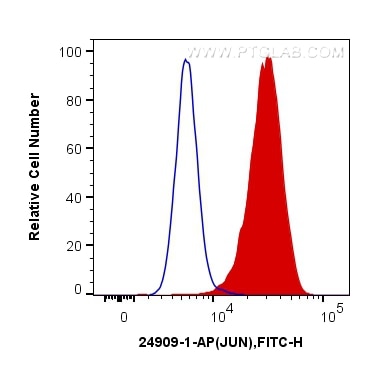Tested Applications
| Positive WB detected in | UV treated HeLa cells, C6 cells, HEK-293 cells, HeLa cells, NIH/3T3 cells, UV treated NIH/3T3 cells, HepG2 cells |
| Positive IHC detected in | human lung squamous cell cancer Note: suggested antigen retrieval with TE buffer pH 9.0; (*) Alternatively, antigen retrieval may be performed with citrate buffer pH 6.0 |
| Positive IF/ICC detected in | NIH/3T3 cells |
| Positive FC (Intra) detected in | NIH/3T3 cells |
Recommended dilution
| Application | Dilution |
|---|---|
| Western Blot (WB) | WB : 1:1000-1:6000 |
| Immunohistochemistry (IHC) | IHC : 1:500-1:2000 |
| Immunofluorescence (IF)/ICC | IF/ICC : 1:50-1:500 |
| Flow Cytometry (FC) (INTRA) | FC (INTRA) : 0.20 ug per 10^6 cells in a 100 µl suspension |
| It is recommended that this reagent should be titrated in each testing system to obtain optimal results. | |
| Sample-dependent, Check data in validation data gallery. | |
Published Applications
| KD/KO | See 4 publications below |
| WB | See 84 publications below |
| IHC | See 6 publications below |
| IF | See 18 publications below |
| IP | See 3 publications below |
| CoIP | See 2 publications below |
| ChIP | See 6 publications below |
Product Information
24909-1-AP targets JUN in WB, IHC, IF/ICC, FC (Intra), IP, CoIP, ChIP, ELISA applications and shows reactivity with human, mouse, hamster samples.
| Tested Reactivity | human, mouse, hamster |
| Cited Reactivity | human, mouse, rat, chicken |
| Host / Isotype | Rabbit / IgG |
| Class | Polyclonal |
| Type | Antibody |
| Immunogen |
CatNo: Ag17639 Product name: Recombinant human JUN protein Source: e coli.-derived, PET28a Tag: 6*His Domain: 92-227 aa of BC068522 Sequence: PTPTQFLCPKNVTDEQEGFAEGFVRALAELHSQNTLPSVTSAAQPVNGAGMVAPAVASVAGGSGSGGFSASLHSEPPVYANLSNFNPGALSSGGGAPSYGAAGLAFPAQPQQQQQPPHHLPQQMPVQHPRLQALKE Predict reactive species |
| Full Name | jun oncogene |
| Calculated Molecular Weight | 331 aa, 36 kDa |
| Observed Molecular Weight | 39 kDa |
| GenBank Accession Number | BC068522 |
| Gene Symbol | JUN |
| Gene ID (NCBI) | 3725 |
| RRID | AB_2860574 |
| Conjugate | Unconjugated |
| Form | Liquid |
| Purification Method | Antigen affinity purification |
| UNIPROT ID | P05412 |
| Storage Buffer | PBS with 0.02% sodium azide and 50% glycerol, pH 7.3. |
| Storage Conditions | Store at -20°C. Stable for one year after shipment. Aliquoting is unnecessary for -20oC storage. 20ul sizes contain 0.1% BSA. |
Background Information
JUN is also named as c-Jun and AP1, belongs to the bZIP family and Jun subfamily. JUN, the most extensively studied protein of the activator protein-1 (AP-1) complex, is involved in numerous cell activities, such as proliferation, apoptosis, survival, tumorigenesis and tissue morphogenesis[PMID: 22180088]. JUN is a transcription factor that recognizes and binds to the enhancer heptamer motif 5'-TGA[CG]TCA-3'. It promotes activity of NR5A1 when phosphorylated by HIPK3 leading to increased steroidogenic gene expression upon cAMP signaling pathway stimulation. JUN is a basic leucine zipper (bZIP) transcription factor that acts as homo- or heterodimer, binding to DNA and regulating gene transcription[PMID: 9732876]. In additon, extracellular signals can induce post-translational modifications of JUN, resulting in altered transcriptional activity and target gene expression[PMID:8464713]. More over, it has uncovered multiple layers of a complex regulatory scheme in which JUN is able to crosstalk, amplify and integrate different signals for tissue development and disease. Jun is predominantly nuclear, ubiquitinated Jun colocalizes with lysosomal proteins[PMID: 15469925]. This antibody is a rabbit polyclonal antibody raised against a region of human JUN. Both phosphorylated (p-c-Jun) and unphosphorylated forms of c-Jun, with sizes of 42-45 kDa and 36-39 kDa, respectively are obtain in some experiments. (PMID: 17210646)
Protocols
| Product Specific Protocols | |
|---|---|
| IF protocol for JUN antibody 24909-1-AP | Download protocol |
| IHC protocol for JUN antibody 24909-1-AP | Download protocol |
| WB protocol for JUN antibody 24909-1-AP | Download protocol |
| Standard Protocols | |
|---|---|
| Click here to view our Standard Protocols |
Publications
| Species | Application | Title |
|---|---|---|
Cell Metab CircACC1 Regulates Assembly and Activation of AMPK Complex under Metabolic Stress.
| ||
Cell Host Microbe Veillonella intestinal colonization promotes C. difficile infection in Crohn's disease | ||
Biomaterials Material-driven immunomodulation and ECM remodeling reverse pulmonary fibrosis by local delivery of stem cell-laden microcapsules | ||
Nat Commun Proteomic profiling and genome-wide mapping of O-GlcNAc chromatin-associated proteins reveal an O-GlcNAc-regulated genotoxic stress response. | ||
Nat Commun TNF antagonist sensitizes synovial fibroblasts to ferroptotic cell death in collagen-induced arthritis mouse models. |

